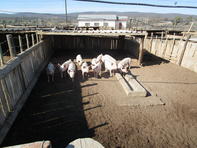In small pig herds with inexpensive input costs like home-built housing and cheap feed, there is a basic problem; not enough saleable pigs. This means there are not enough pigs and meat to make a profit.

There are various reasons for this but it can mostly be attributed to breeding problems. Either the herd has unsuitable pigs or the breeding program is not developed or not followed. Fortunately, small pig farmers in South Africa can improve the breeding of pigs.
Get the Right Breeding Pigs
Over the last hundred years, a steady stream of the long, white, fast-growing and prolific sows and boars have been imported by South African breeders and the genes of these pigs have been spread through the local herds. This has increased the potential for commercial herds to develop in informal situations, but this demands more care and management.
If there is a commercial pork producer who has the occasional surplus of slaughter pigs, these will make excellent basic small-herd breeding stock. These pigs have the genes that will raise the quality of the herd and will cost less than highly selected breeding animals. Artificial Insemination (AI) is the quickest and safest way to improve the genetic level of a breeding herd.
This involves more logistics, expertise and expenditure than a herd producing less than one litter per week can justify, that is with less than 25 sows. As a rule one should not buy any pig that you do not know anything about – avoid auctions and speculator pigs - as this might increase the risk of buying animals with diseases and poor genes.
Talk to your local animal health technician in the area for information on the prevalent diseases and any restrictions.
Choosing Breeding Females
The only job of a sow is to produce healthy, well-grown weaners twice per year. Big litters born alive are only an advantage to the pig farmer if their mother can feed and care for them up to weaning age.
Gilts (young unmated female pig) and sows can be selected from the existing home herd or that of a neighbour (with disease-free pigs), provided that only the best females from the best mothers are used.
Choosing a Boar
A pig farmer should invest money in a good boar. Sharing a boar may lead to the spreading of sexually transmitted diseases between pig herds. A boar may be shared between farmers provided that some rules are applied: The boar should come from a nearby herd with the same level of biosecurity and a record of successful mating.
The boar should not be related to any female that he serves and should be moved away to another area after two years to avoid inbreeding. There should be a boar for every 12 to 16 females and he should not serve more than three times per week.
The Breeding Cycle of Pigs
Breeding with pigs has some easy numbers which can be used to measure the planned production and the standards. Sows come on heat in cycles of three weeks. They will remain receptive to the boar for two or three days, during which she should be mated three times at 12 to 24-hour intervals.
Keep the boar away from the sows between services and make sure he is not interrupted while serving, which may take ten or fifteen minutes. If the sow comes on heat 18 to 22 days after being served it means the mating was unsuccessful and she should be served again preferably with another boar if there is one.
If the mating was successful the sow will be pregnant for 114 to 116 days (16 weeks and three days). She can spend this time in open camps with other pregnant (“dry”) sows until a week before farrowing (giving birth). Several days before birth she should be moved to a special shelter with plenty of bedding – pine shavings are best but wheat straw, maize stover, teff hay or veld-cuttings will do.
She will usually spend time making a sort of nest which is good because there it can ensure a more natural birthing and milk production. Be sure to remove anything sharp or broken and create a safe escape space – a farrowing rail or strong beam mounted securely about 20 cm from floor and wall will prevent a lot of crushing of sucklers.
Recordkeeping in Pig Farming
Write down all the important dates and events about your pigs, their breeding and feeding. This should include: The sow’s number (or her name), the boar serving her, dates of her heat cycles, her expected farrowing date and actual farrowing date. Also record all the details of the pig litter.
This should include the number of piglets born alive and those dead at birth. Also, note down the number of piglets dying during the suckling period. Also, document the date of weaning (usually at 4 to 6 weeks old) and the total piglets successfully raised by that sow. It is very important to record the procedures performed in the suckling period.
This should include an iron injection to prevent anaemia at 3 – 6 days, identifying best gilts (unbred females), mange treatment and vaccinations, ear notching with a purpose-made instrument with a pattern for numbering and tattooing with a registered tattoo. Tattooing pigs is a legal requirement - see the section on management of weaners.
By Dr Jim Robinson